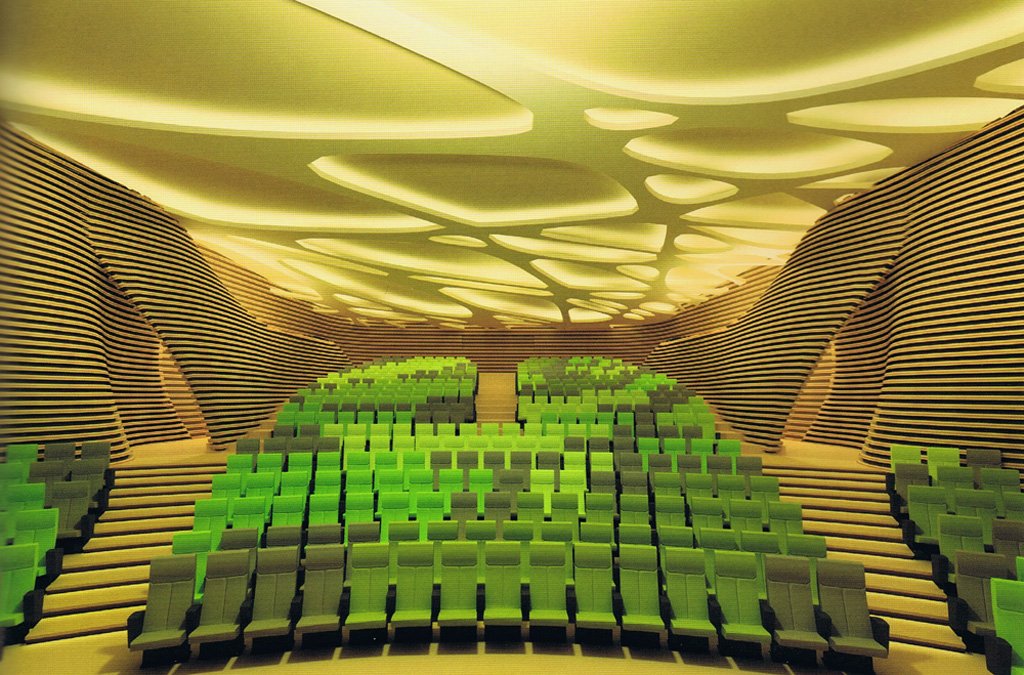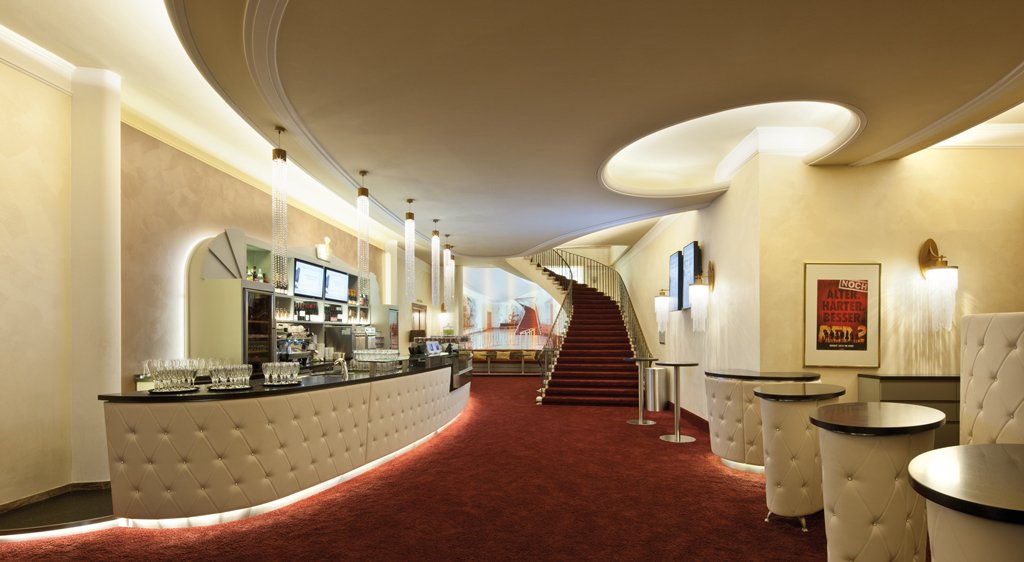Fairy Tale Castle or Black Box?
Cinema architecture of the future – by Anne Batisweiler
A presentation given by designer Anne Batisweiler at this year’s HDF Cinema Conference in Baden-Baden focused on forward-looking features and quality design in cinema architecture. As her presentation is of international interest, we chose to reprint it here.

Cinema is dead – long live cinema! It has been pronounced dead a thousand times over yet it is more successful than ever. What is he reason for this? Is there a future? And if there is one: what will it look like and why?
In order to answer these questions we have to take a short time lapse excursion into the history of cinema. After Louis and Auguste Lumière first publicly screened a series of short films on December 28 1885, the new medium spread via travelling movie theaters, variety shows and cinematographs at carnivals. The way I see it, the event character of cinema and the strong ties the medium has with event architecture that continues to fascinate people and draws them to the theatres just as the films themselves do, can already be discerned here. At the beginning of the 20th century cinema had moved into proper halls hat quickly evolved into veritable movie palaces. These early buildings resembled traditional theaters and tried to outdo each other with spectacular architecture and sumptuous interiors. Soon however, purpose-built movie theaters like the Titania Palast in Berlin created a new environment for the movies. Their weekly newsreels were bread and games for everyone. The most divergent social groups were mad about the movies and came together there. This has remained largely unchanged to the present day, i.e. it is an essential characteristic of cinema. So cinema has historically been and still the medium of the people. Compared to theater or opera performances, rock concerts or sport events, culture and entertainment can be enjoyed at the movies for a considerably lower admission price. The newsreels also served as a window to the world and create a connection between soldiers in the field and their families at home. For the men on the front line movies often were the only means of recreation and compensation fort he harsh reality in their fight for survival. Cinema´s potential to reach any one regardless of age, social status or whereabouts was identified by the Nazi regime and successfully used for propaganda purposes. Many new movie palaces were built in styles that suited national socialist ideology.
But technical innovations brought about changes in the architecture of movie theatres as well: While in the silent film era there had to be room for a piano player, a narrator or an orchestra the advent of sound film meant that these space could be used for additional seats. Simultaneously, an increasing number of speakers meant that more space was required behind the screen and on the walls of the auditorium. After the war in the 1950s schmaltzy “Heimatfilms” created an atmosphere of promise, ease and confidence and helped audiences to forget their troubles and the horrors of war – at least for a few hours. In the light of these circumstances it is not surprising that despite a severe lack of funds and building material cinemas were shooting up like mushrooms in the post-war period before the founding of the Federal Republic of Germany. During the Wirtschaftswunder years, the number of movie theaters rose from 2,125 to 6,239 in West Germany and 7,662 in Germany as a whole within ten years. The cinemas were packed and the box-of-fice takings were good. The cinema boom gave rise to a new kind of cinema architecture that incorporated the style of the time with its elegant sweeping lines, asymmetrical auditoria, pleated textile wall linings, dainty rails on self-supporting galleries and arched stairways, suspended strip lights and colorful neon letters on the walls, abundant use of glass mosaic in the lobby and even color organs and water features in the auditorium. Does this sound familiar to you?
The advent of television in the 1960s and 1970s brought about a difficult time for cinema. Colored film and later Technicolor gave cinema a slight edge over black and white TV but the sharp drop in attendance drove many theatres to divide their auditoria up into shoe-box-sized cinemas and ushered in the demise of the classic movie theaters. The mass releases and blockbuster strategies introduced by the American film industry that had come to dominate the increasingly global market made larger cinema structures viable once again. American companies were the first to start building multiplex theaters in Europe in places with good transport links either in the city centers or on the green field.

The introduction of the THX sound system added to the development: Cinema technology had to improve immensely to brave the advent of home video. The early 1990s saw a rapid spread of multiplex theatres with better screen visibility and projectors, Dolby SR sound, THX baffle walls, spacious lobbies and additional culinary offerings via incorporated or outsourced catering areas. Large glass fronts, often shared with shopping malls, made sure that the new meeting places were highly visible. While large German theatres chains also proliferated, small and midsize theatres had to invest in renovations and especially in improved acoustics in order to survive in the marketplace.
The spread of large cinema complexes brought about a fierce competition regarding convenience and technology that in turn gave rise to VIP and premium cinemas. With the beginning of the 21st century, the success story of digital projection technology began. 2K, 4K and laser projectors replace 35mm equipment and voluminous platters. The film “Avatar” ushers in a new category of crowd-puller: 3D cinema. Although there is still a place for 2D cinema as not everybody likes to wear glasses, the digital technology is here to stay. It physical dimensions are diminishing making separate projection rooms obsolete and creating space for lounges, bars, wardrobes or gaming areas, etc. Room is created for new ideas and new business!
New three-dimensional sound systems like Dolby Atmos or Barco´s Auro offer new highlights for moviegoers that go beyond home cinema and flat screen TVs. The new surround sound technology that fills the entire auditorium makes for an even more immersive experience for the audiences. George Lucas said: “Sound is 50 percent of the movie going experience.” An indispensable prerequisite for putting this knowledge into practice are high structural and acoustical standards in the design of auditoria.
Let us summarize the historical facts: Cinema as a shared social experience and an expansion of awareness, as cultural mediator and a stage for dreams, alternate worlds, timelines and events has, by means of technical development and improvement of the viewing experience, always managed to fend off the threats posed by television, video tape, DVDs or home cinema. This has required investments and repeated structural and technical modifications as well as changes in the interior design. Today, “mobile cinema” is the buzzword that conjures up the idea that the digital world poses a danger to movie theatres: PCs, the internet, smart phones and tablet PCs the so-called third and fourth screen technologies, it is said, threaten the existence of the first, the silver screen. In a report published by the “Süddeutsche Zeitung” on July 19 2013, Steven Spielberg and George Lucas warned of an impending “implosion” of the film industry but also stated that cinema would survive. But is this really true? At the threshold to the new digital world, what is to be the future of cinema architecture? How will things evolve? What’s must be considered, what must be done in order to survive?
First of all, one has to formulate visions of the future of society and the concept it has of itself. The demographic trend towards an aging population and the problems for the less numerous, younger generations that it entails, financial crises, unemployment, sensory overload, the rise of lifestyle diseases, Europe and globalization, climate change, etc. – all of these problems require concepts as to how they can be overcome.
Let us remember the power the movies have shown in times of war and during post-war periods to distract audiences from fear, worry and desperation, the sense of community, social cohesion, and the development of positive options that they inspired and gave a place to. In its unparalleled capacity to serve as a platform for events that truly bring people together I see an enormous and valuable advantage that the movie theatre has over all other digital media.
 Examples of creative spaces, lighting ideas and “new seating”.
Examples of creative spaces, lighting ideas and “new seating”.
Another concern of modern cinema architecture is the progress of technology
3-D cinema visionary James Cameron has been working on “glasses-free” auto-stereoscopic screens for some time now. Globally, only one theatre has been outfitted with the new technology to date, the Moskva in Moscow. The enormous technical and monetary expense involved makes the example unfit for series production – but the again, wasn’t it the same with space travel? Cinema has always anticipated developments that have become staples of everyday life lateron. Remember the holodeck technology from Star Trek? On September 10 2013 – just about a year ago – “Die Welt” published an article that hailed holography as the next stage after 3-D. The aim nowadays is no project holographic images in real time. Like a surround sound system, they will immerse the audience even more deeply into the action. Auditoria will take on the shape of amphitheatres or circuses and they will require large dimensions for the effect to work to the fullest. With holography as a true mirror of the universe, the world beyond the mirror achieves perpetuity and becomes indefinitely reproducible. And will this virtual world be projected into space or will it projected directly into our brains?
And what about interactive films in interactive theatres? Right now, there are experiments in participatory films for the youngest audiences underway. Isn’t that a first step into this direction? When I talked to my son (14) about this, he voiced some concerns. He doesn’t want to be a part of every movie scenario – what if it was a war movie or a horror film? I believe, he is right. But then an again, I don’t watch horror movies anyway, not even in 2-D and with Dolby 5.1. sound…
However, I won’t send you off with such grave problems and the prospect of large-scale reconstruction. With some limitations applying, there are plenty of things in cinema architecture – large and small alike – that can be carried out in the near future and on a manageable budget.
Let’s make use of the experiences made in retail. Every shop, every business has felt the competition of online shops and many have been crushed by it. But how do the survivors react? In their quest for the customer’s attention they are developing scenic space concepts with high experience quality. At ever-shorter intervals modernizations are carried out and new design trends emerge: lifestyle, adventure, event culture, retro look, or authenticity to name just a few themes. The shop becomes a stage and the customers are offered a surface onto which to project their desire for identity and affiliation.
To achieve this there is an intensive collaboration of architects, interior designers, lighting designers, and color designers as well as professionals from new areas such as playwrights, sound designers or product designers. Know-how from diverse fields such as theatres, film and psychology is applied to create sensual, emotional presentations. This approach can be transferred to lobbies and auditoria before and after the show.
A movie theater with a future is a theater that has been upgraded both technically and with respect to design. Its proprietors define specific target groups and offer them the individuality they require. It can be a premium cinema (for the best agers), an event and entertainment center (for the younger generation) with show effects (water features or laser shows) and versatile interiors.
This versatility can be achieved through lighting, floor-to-ceiling photo walls with backlighting, where appropriate and/or visible ceilings that are upgraded with interesting designs. Projections, sliding or rotating wall elements, string curtains, light effects and even green walls or water walls can also be used to create a new look and a new spatial impression.
In collaboration with the manufacturer Osram, a special window display with organic LEDs (OLEDs) was designed for the luxury emporium Department store Quartier 206 in Berlin last fall. OLEDs open up new possibilities for lighting designers while they outclass fluorescent lighting and conventional LEDs in energy efficiency and life span. OLEDs are luminous surfaces that consist of ultra-thin layers of semiconductors that have been vapor-deposited on glass or other materials. Depending on the backplane they can be either transparent, white, or reflective when switched off.
New lighting technologies can be integrated into fabric and building materials. Imagine illuminated upholstery on seats or luminous curtains that can be completely dimmed down when the show starts. Or how about illuminated floor path markings that are only visible when one walks to the theater or back to the lobby after the movie?
Kids and adolescents love to be different and to distinguish themselves from the lifestyle of the adults. Computers and the Internet may be important but they still enjoy gathering in creative spaces of their own. To them live broadcasts of pop concerts or sports events take on a whole new quality and dynamic in theatres that have been re-designed especially for them. You could even remove the seats completely. There are fastening mechanisms are under development that allow for a quick removal and re-installation of seats – this is where the extra space in the projection rooms might come in handy. I can imagine completely new seating concepts, for example the use of “Fatboy”-style beanbags that are fastened to the floor instead of conventional seats. RGBW-controlled lighting floods the auditorium with different colors matching the mood of the film. Projections on the ceiling and the walls create a permanently changing background in the room and complement the scenery in the movie.
Just as I believe in the future of cinema, I belief in the future of movie theatres. There were always stories to be told – among the caveman and in today’s tabloids. Let us create great environments for experiencing these stories. You have a wonderful profession and your theatres provide a unique, marvellous space, unsurpassed in its potential to be the best setting imaginable for these experiences!
 Cinema “Gloria Palast” in Munich – Kinoplanung Batisweiler
Cinema “Gloria Palast” in Munich – Kinoplanung Batisweiler
source: filmecho 16/2014
Author: Anne Batisweiler
Publisher: Horst Axtmann GmbH
www.filmecho.de






